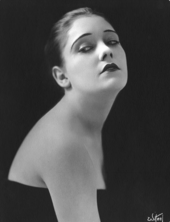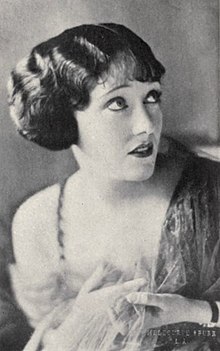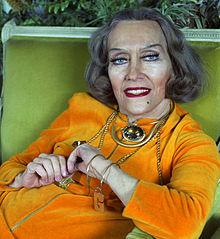Gloria Swanson
Swanson left school, and was soon hired to work in California for Mack Sennett's Keystone Studios comedy shorts opposite Bobby Vernon.
She spent some of her childhood in Key West, Florida, where she was enrolled in a Catholic convent school,[5] and in Puerto Rico, where she saw her first motion pictures.
[6] Her family once again residing in Chicago, the adolescent Gloria developed a crush on actor Francis X. Bushman and knew he was employed by Essanay Studios in the city.
[7] The movie industry was still in its infancy, churning out short subjects, without the advantage of today's casting agencies and talent agents promoting their latest find.
[11] Swanson's mother accompanied her to California in 1916 for her roles in Mack Sennett's Keystone Studios comedy shorts opposite Bobby Vernon and directed by Clarence G. Badger.
[22] While she and her father were dining out one evening, the man who would become her second husband, Equity Pictures president Herbert K. Somborn, introduced himself, by inviting her to meet one of her personal idols, actress Clara Kimball Young.
[24] She next appeared in 10 films directed by Sam Wood,[25] starting with The Great Moment (1921) and including Beyond the Rocks in 1922 with her longtime friend Rudolph Valentino.
[26][27] Valentino had become a star in 1921 for his appearance in The Four Horsemen of the Apocalypse, but Swanson had known him since his days as an aspiring actor getting small parts, with no apparent hope for his professional future.
[34] She turned down a one-million-dollar-a-year (equivalent to $17,500,000 in 2023)[10] contract with Paramount in favor of joining the newly created United Artists partnership on June 25, 1925, accepting a six-picture distribution offer from president Joseph Schenck.
[39] The film, co-starring John Boles, was directed by Albert Parker, based on the play The Eyes of Youth by Max Marcin and Charles Guernon.
[41] She engaged the services of director Raoul Walsh in 1927 and together they conceived of making a film based on W. Somerset Maugham's short story "Miss Thompson".
[42] Gloria Swanson Productions proposed to film the controversial Sadie Thompson about the travails of a prostitute living in American Samoa, a project that initially pleased United Artists president Joseph Schenck.
[55] Kennedy, however, advised her to hire Erich von Stroheim to direct another silent film, The Swamp, subsequently retitled Queen Kelly.
[61] Written by Edmund Goulding, with Laura Hope Crews fine-tuning the dialogue, Kennedy approved funding for the go-ahead on the production.
The brainchild of Joseph Schenck, it was a promotional come-on to attract audiences into movie theaters to hear the voices of their favorite actors, as sound productions became the future of commercial films.
[71] United Artists bought back all of her stock with them, in order to provide her financing to make this film, and thereby ending her relationship with the partnership.
[72] When she made the transition to sound films as her career simultaneously began to decline, Swanson moved permanently to New York City in 1938.
[76] She toured in summer stock, engaged in political activism, designed and marketed clothing and accessories, and made personal appearances on radio and in movie theaters.
[78] The film Sunset Boulevard was conceived by director Billy Wilder and screenwriter Charles Brackett, and came to include writer D. M. Marshman Jr.[79] They bandied about the name of Mae West, whose public persona even in her senior years was as a sex symbol, but she objected to playing a has-been.
[81] It was director George Cukor who suggested Swanson, noting that she was once such a valuable asset to her studio that she was "carried in a sedan chair from her dressing room to the set".
[80] The storyline of the film follows a faded silent movie actress Norma Desmond (Swanson), in love with a failed screenwriter Joe Gillis (William Holden).
[85] During the scene leading up to Cecil B. DeMille's cameo, where Max chauffeurs Joe and Norma to the studio, her Isotta Fraschini luxury automobile was towed from behind the camera, because Stroheim had never learned how to drive.
Max sets up the studio lighting towards her on the staircase and directs her down towards the waiting police and news cameras,[87] where she says, "All right, Mr. DeMille, I'm ready for my close-up.
"[93] In 1956, Swanson made Nero's Mistress, an Italian film shot in Rome, which starred Alberto Sordi, Vittorio de Sica and Brigitte Bardot.
[101] She acted in "Behind the Locked Door" on The Alfred Hitchcock Hour in 1964 and, in the same year, she was nominated for a Golden Globe award for her performance in Burke's Law.
[106] Actor and playwright Harold J. Kennedy, who had learned the ropes at Yale and with Orson Welles' Mercury Theatre, suggested Swanson do a road tour of "Reflected Glory", a comedy that had run on the Broadway stage with Tallulah Bankhead as its star.
[120][121] Joining Swanson and Eisley at the Project Prayer rally were Walter Brennan, Lloyd Nolan, Rhonda Fleming, Pat Boone, and Dale Evans.
[148] In spite of the divorce they remained close, and Falaise became a partner in her World War II efforts to aid potential scientist refugees fleeing from behind Nazi lines.
[73] In 1939, she created Multiprises, an inventions and patents company; Henri de la Falaise provided a transitional Paris office for the scientists and gave written documentation to authorities guaranteeing jobs for them.
[176][177] Her body was cremated and her ashes interred at the Church of the Heavenly Rest on Fifth Avenue in New York City, attended by a small number of family members.














